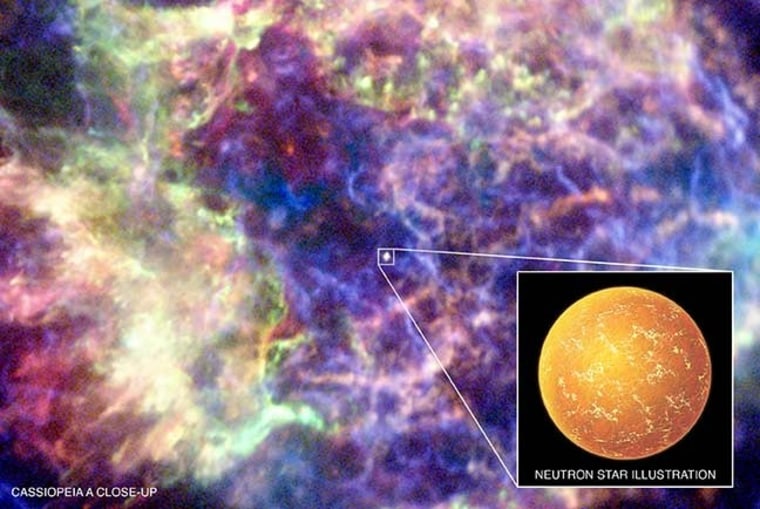The supernova remnant Cassiopeia A, one of the youngest in our galaxy and one that has long puzzled astronomers, is likely a dense type of star called a neutron star swathed in a carbon atmosphere, a new study finds.
Cassiopeia A, a remnant of the explosion of a star that once shone brightly, is thought to be just 330 years old based on observations of the constellation in which it sits by Britain's first Astronomer Royal, John Flamsteed, in 1680.
Astronomers didn't get their first actual up-close glimpse of the core remnant, which lies about 11,000 light-years away, until 1999, when the Chandra X-ray Observatory imaged the collapsed star.
"Before then it was thought there's probably going to be either a neutron star or a black hole in the center of this object, but it wasn't sure what — nobody had seen it," said Craig Heinke of the University of Alberta in Canada and a co-author of the new study. With Chandra "we were actually able to pick out something at the center."
But even with a closer view of the object, it still puzzled astronomers: "The properties of this object were a little strange," Heinke said.
Puzzling properties
In particular, the star's spectrum — the amount of energy it radiates out at each wavelength of light — implied that the star's radius was either much too small for a neutron star (only 0.1 miles [0.2 km] in radius, instead of the accepted 12 miles [20 km]) or that the high-energy emission seen from it was coming from hotspots on the surface, not from the entire face of the star. But radiation from a hotspot would appear as a pulse as the star rotated, and no pulsations were seen in the star's radiation. The star also had a low magnetic field, which would be unlikely to drive any pulsing behavior.
Since a pulsating star with surface hotspots seemed to be out of the equation, Heinke and his colleague Wynn Ho of the University of Southampton in the U.K. tried to find a way to tackle the size problem.
To do this, they first added an atmosphere to models of the star. They first tried a hydrogen atmosphere, as it was thought that in the extreme gravitational field of a neutron star, the star's layers would quickly stratify, with the heaviest elements relegated to the interior and the lightest to the outermost layer. Hydrogen, of course, is the lightest element in the universe.
Slideshow 12 photos
Month in Space: January 2014
A hydrogen atmosphere ballooned the star's size up to 2.5 miles (4 km) in radius — better, but still not big enough. Trying a helium atmosphere also "helped, but not very much," Heinke said.
Next on the list was carbon, and sure enough, that gave a radius in the models "that was in the right ballpark for neutron stars," Heinke said.
But that left the researchers with another question: How did the star end up with an atmosphere made up entirely of carbon?
Carbon atmosphere
That's where the star's youth comes into play.
"This is the youngest neutron star that we have ever observed," Heinke said. "The fact that this is so young means that it's been really, really hot the most recently of any neutron stars."
In this case, "hot" means temperatures up to 1 billion degrees Kelvin (2 billion Fahrenheit). Ho and Heinke think that the star "was actually able to conduct nuclear fusion on its surface and burn the hydrogen and helium into carbon," Heinke explained. (The hydrogen and helium came from a continuous rain falling onto the star's surface from the supernova debris.)
As the star gets older, it will cool substantially and eventually stop burning the hydrogen and helium into carbon and develop a hydrogen atmosphere, Heinke said.
He and Ho plan to test this model on other known young neutron stars to see how well it holds up. Their findings are detailed in the Nov. 5 issue of the journal Nature.

